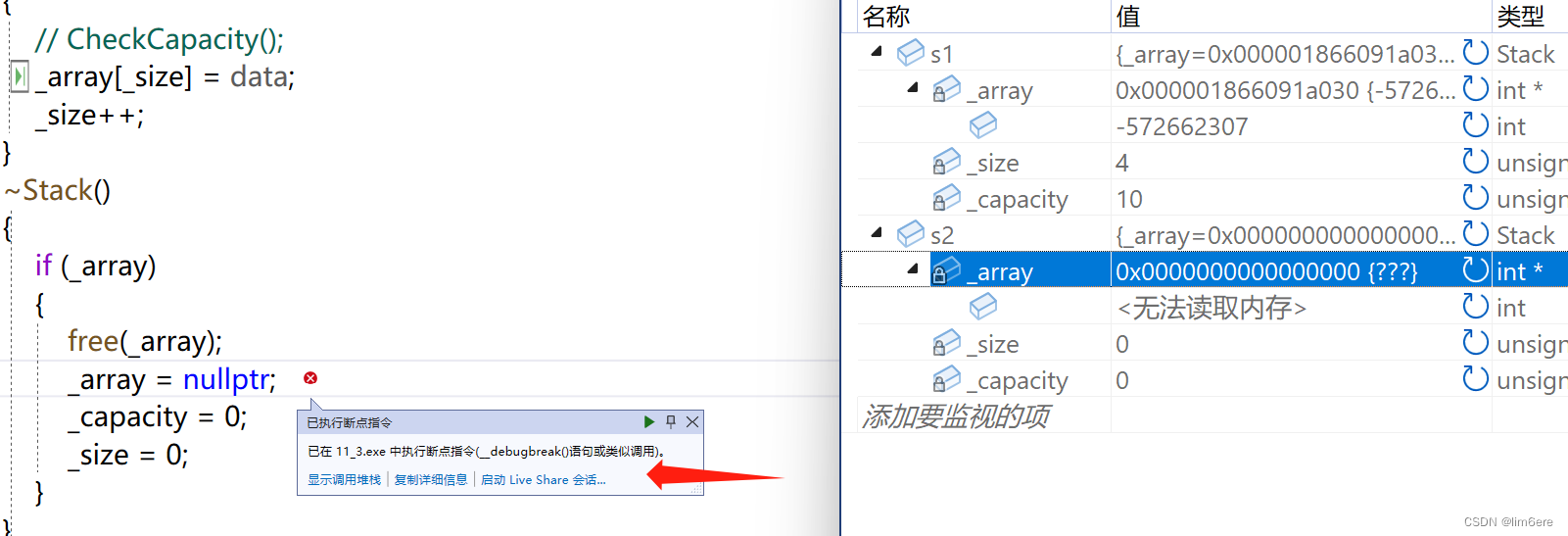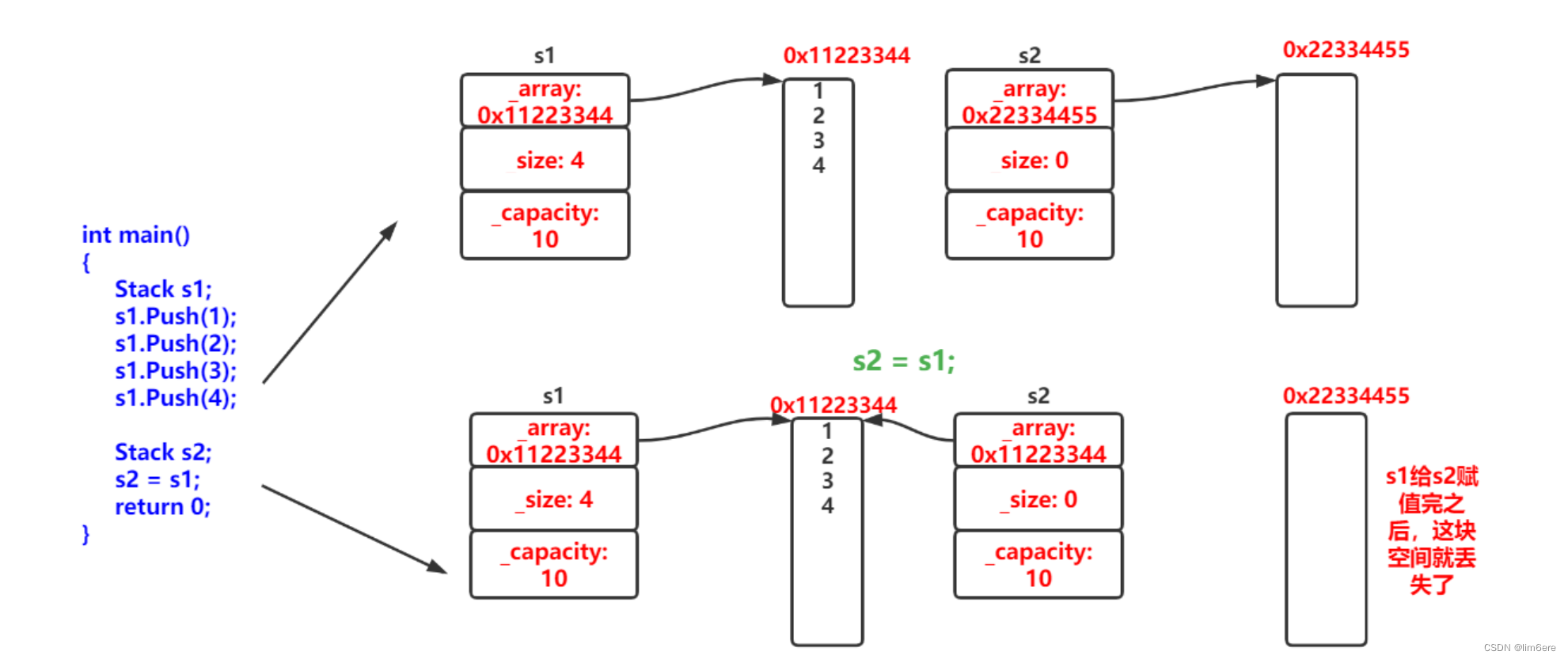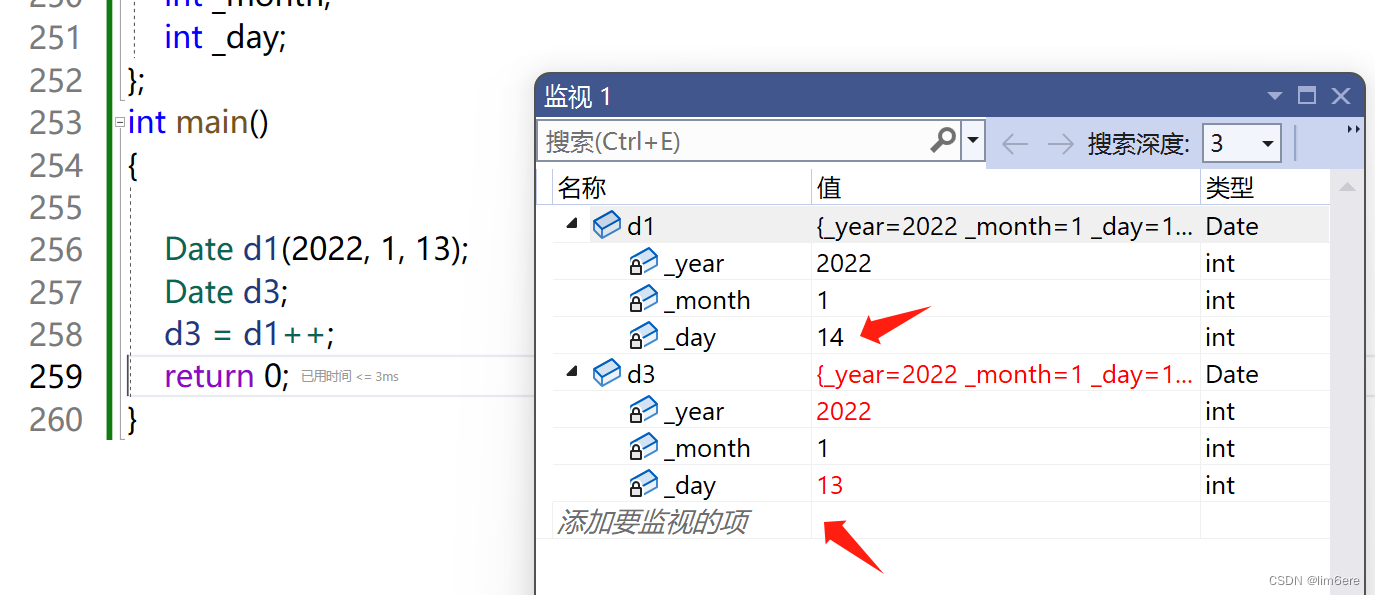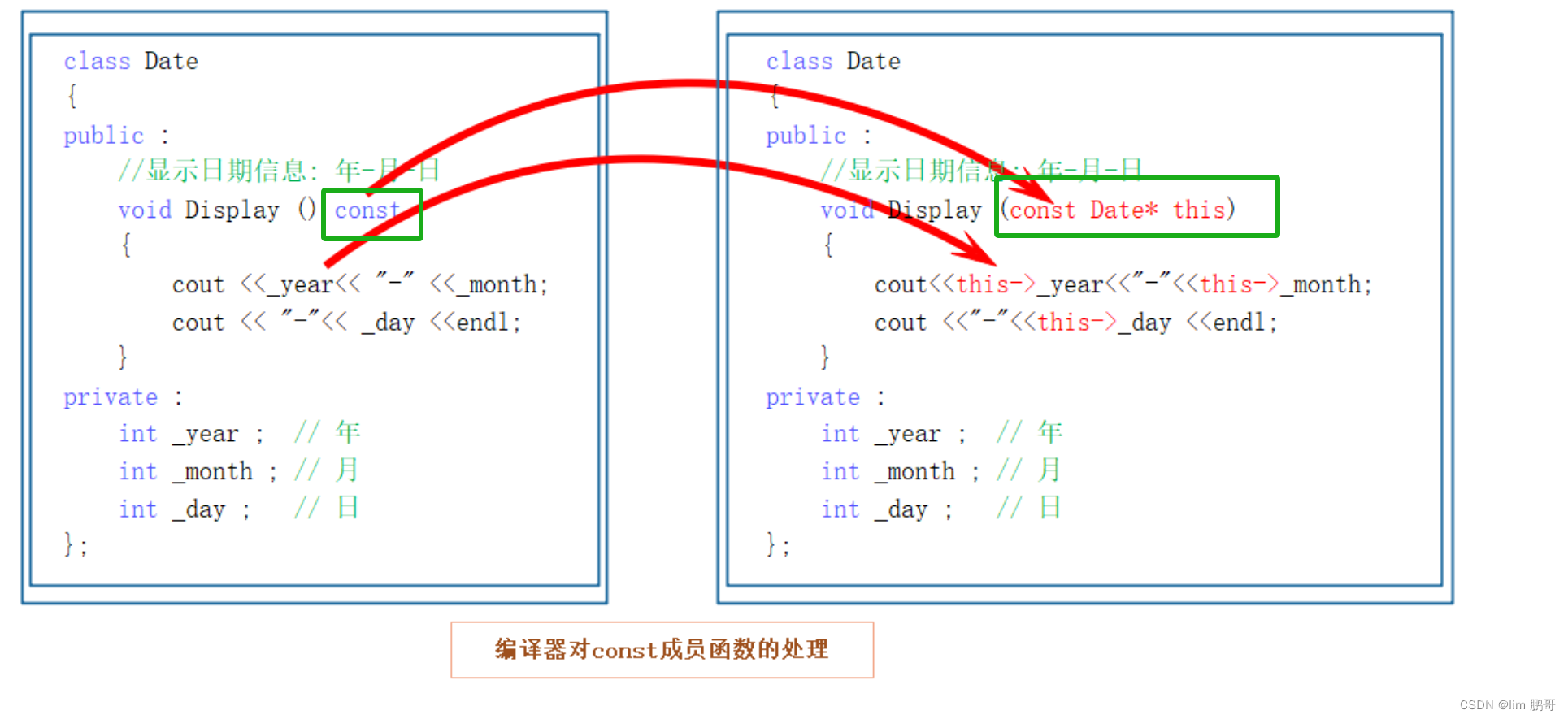文章目录
一、 运算符重载
🏉在介绍赋值运算符重载时,需要先介绍一下 运算符重载
🏉自定义类型是不支持各种运算符的,需要通过一定的函数进行实现
C++为了增强代码的可读性引入了运算符重载,运算符重载是具有特殊函数名的函数,也具有其返回值类型,函数名字以及参数列表,其返回值类型与参数列表与普通的函数类似。
函数名字为:关键字operator后面接需要重载的运算符符号。
函数原型:返回值类型 operator操作符(参数列表)
注意:
⭐️不能通过连接其他符号来创建新的操作符:比如operator@
⭐️重载操作符必须有一个类类型参数
⭐️用于内置类型的运算符,其含义不能改变,例如:内置的整型+,不能改变其含义
⭐️作为类成员函数重载时,其形参看起来比操作数数目少1,因为成员函数的第一个参数为隐藏的this
⭐️.*(特殊) ::(域作用限定符)sizeof(计算大小) ?: (三目操作符). (结构体中的点)
注意以上5个运算符不能重载。
☀️☀️那这个具体怎末实现呢??
💙看一下下面这段代码
// 全局的operator==
class Date
{
public:
Date(int year = 1900, int month = 1, int day = 1)
{
_year = year;
_month = month;
_day = day;
}
//private:
int _year;
int _month;
int _day;
};
//写在类外边
bool operator==(const Date& d1, const Date& d2)
{
return d1._year == d2._year
&& d1._month == d2._month
&& d1._day == d2._day;
}
void Test()
{
Date d1(2018, 9, 26);
Date d2(2018, 9, 27);
/*bool ret= d1 == d2;
cout << ret << endl;*/
//加括号是为了优先级
cout << (d1 == d2) << endl;
}
这里会发现运算符重载成全局的就需要成员变量是公有的,那么问题来了,封装性如何保证?💙
💜那如果定义在类中呢
class Date
{
public:
Date(int year = 1900, int month = 1, int day = 1)
{
_year = year;
_month = month;
_day = day;
}
// bool operator==(Date* this, const Date& d2)
// 这里需要注意的是,左操作数是this,指向调用函数的对象
bool operator==(const Date& d2)
{
return _year == d2._year
&& _month == d2._month
&& _day == d2._day;
}
private:
int _year;
int _month;
int _day;
};
void Test()
{
Date d1(2018, 9, 26);
Date d2(2018, 9, 27);
/*bool ret= d1 == d2;
bool ret1=d1.operator == (d2);
cout << ret << endl;*/
//加括号是为了优先级
//这种写法交给编译器处理
cout << (d1 == d2) << endl;
}
这样就可以避免上述问题
二、赋值运算符重载
1. 赋值运算符重载格式
🌟参数类型:const T&,传递引用可以提高传参效率
🌟返回值类型:T&,返回引用可以提高返回的效率,有返回值目的是为了支持连续赋值
🌟检测是否自己给自己赋值
🌟返回*this :要符合连续赋值的含义
class Date
{
public:
Date(int year = 1, int month = 1, int day = 1)
{
_year = year;
_month = month;
_day = day;
}
bool operator ==(const Date& d2)
{
return _year == d2._year
&& _month == d2._month
&& _day == d2._day;
}
bool operator !=(const Date& d2)
{
return !(*this == d2);
}
//参数,返回值
Date& operator =(const Date& d2)
{
//检测是否自己给自己赋值,对地址进行比较,而不是*this!=d2,这样还要生成拷贝
if (this != &d2)
{
_year = d2._year;
_month = d2._month;
_day = d2._day;
}
//this,出了这个作用域还在,可以用拷贝返回
return *this;
}
private:
int _year;
int _month;
int _day;
};
void test1()
{
Date d1(2023, 11, 3);
Date d2(2022, 1, 3);
//进行赋值
Date d3 ;
d3=d2;
}
2.赋值运算符只能重载成类的成员函数不能重载成全局函数
class Date
{
public:
Date(int year = 1900, int month = 1, int day = 1)
{
_year = year;
_month = month;
_day = day;
}
int _year;
int _month;
int _day;
};
// 赋值运算符重载成全局函数,注意重载成全局函数时没有this指针了,需要给两个参数
Date& operator=(Date& left, const Date& right)
{
if (&left != &right)
{
left._year = right._year;
left._month = right._month;
left._day = right._day;
}
return left;
}
void test1()
{
Date d1(2023, 11, 3);
Date d2(2022, 1, 3);
Date d3 = d2;
Date d4 = d1.operator = (d2);
}


原因:赋值运算符如果不显式实现,编译器会生成一个默认的。此时用户再在类外自己实现一个全局的赋值运算符重载,就和编译器在类中生成的默认赋值运算符重载冲突了,故赋值运算符重载只能是类的成员函数。
3.用户没有显式实现时,编译器会生成一个默认赋值运算符重载,以值的方式逐字节拷贝。
内置类型成员变量是直接赋值的
自定义类型成员变量需要调用对应类的赋值运算符重载完成赋值
Date,MyQueue可以不写,Stack必须写
如果类中未涉及到资源管理,赋值运算符是否实现都可以;一旦涉及到资源管理则必须要实现
typedef int DataType;
class Stack
{
public:
Stack(size_t capacity = 10)
{
_array = (DataType*)malloc(capacity * sizeof(DataType));
if (nullptr == _array)
{
perror("malloc申请空间失败");
return;
}
_size = 0;
_capacity = capacity;
}
void Push(const DataType& data)
{
// CheckCapacity();
_array[_size] = data;
_size++;
}
~Stack()
{
if (_array)
{
free(_array);
_array = nullptr;
_capacity = 0;
_size = 0;
}
}
private:
DataType* _array;
size_t _size;
size_t _capacity;
};
int main()
{
Stack s1;
s1.Push(1);
s1.Push(2);
s1.Push(3);
s1.Push(4);
Stack s2;
s2 = s1;
return 0;
}

这里为什么报错呢??

🚀s1对象调用构造函数创建,在构造函数中,默认申请了10个元素的空间,然后存了4个元素1 2 3 4
🚀s2对象调用构造函数创建,在构造函数中,默认申请了10个元素的空间,没有存储数据
🚀由于Stack没有显式实现赋值运算符重载,编译器会以浅拷贝的方式实现一份默认的赋值运算符重载
🚀s2=s1;当s1给2赋值时,编译器会将s1中内容原封不动拷贝到s2中,这样会导致两个问题:
a.s2原来的空间丢失了,存在内存泄漏
b.s1和s2共享同一份内存空间,最后销毁时会导致同一份内存空间释放两次而引起程序崩溃(s2先销毁,s1后销毁)
4.前置++和后置++重载
这两个按照正常写法并不好实现,必须特殊处理
前置++和后置++都是一元运算符,为了让前置++与后置++形成能正确重载
C++规定:后置++重载时多增加一个int类型的参数,但调用函数时该参数不用传递,编译器自动传递
🔆前置++
class Date
{
public:
Date(int year = 1900, int month = 1, int day = 1)
{
_year = year;
_month = month;
_day = day;
}
//前置
Date& operator++()
{
_day += 1;
return *this;
}
private:
int _year;
int _month;
int _day;
};
int main()
{
Date d1(2022, 1, 13);
Date d3;
d3 = ++d1;
return 0;
}

前置++:返回+1之后的结果
this指向的对象函数结束后不会销毁,故以引用方式返回提高效率
🔆后置++
class Date
{
public:
Date(int year = 1900, int month = 1, int day = 1)
{
_year = year;
_month = month;
_day = day;
}
//后置
//形参可写可不写,因为不需要用
Date operator++(int)
{
Date tmp = *this;
_day += 1;
return tmp;
}
private:
int _year;
int _month;
int _day;
};
int main()
{
Date d1(2022, 1, 13);
Date d3;
d3 = d1++;
return 0;
}

后置++:先使用后+1
因此需要返回+1之前的旧值,故需在实现时需要先将this保存一份,然后给this+1
tmp是临时对象,因此只能以值的方式返回,不能返回引用
对于自定义类型,前置++效率高。
三.拷贝构造
编译器规定:对于自定义类型的对象拷贝,需要调用拷贝构造。
特性
1.拷贝构造是构造函数的一个重载形式。
2.拷贝构造的参数只有一个,必须是类型对象的引用。
如果采用传值编译器会报错,这里会引发无穷递归。
3.编译器默认生成的拷贝构造按照字节进行拷贝,完成浅拷贝(值拷贝)。
在编译器生成的默认拷贝构造函数中,内置类型是按照字节方式直接拷贝;
而自定义类型是调用其拷贝构造函数完成拷贝的。
4.如果涉及到资源,就需要我们自己实现拷贝构造。、否则浅拷贝就会将资源释放两次。
拷贝构造函数典型调用场景:
1.使用已存在对象创建新对象
2.函数参数类型为类类型对象
3.函数返回值类型为类类型对象
四.const成员
将const修饰的“成员函数”称之为const成员函数。
const修饰类成员函数,实际修饰该成员函数隐含的this指针
表明在该成员函数中不能对类的任何成员进行修改。

注意const加的位置。
const对象和非const对象都可以调用const成员函数。
成员函数定义原则:
1.能定义成const的成员函数都应该定义成const,这样const对象(权限平移)和非const对象(权限缩小)都可以进行调用。
2.要修改成员变量的成员函数,不能定义成const
五.取地址及const取地址操作符重载
这两个默认成员函数一般不用重新定义 ,编译器默认会生成
class Date
{
public:
Date* operator&()
{
return this;
}
const Date* operator&()const
{
return this;
}
private:
int _year; // 年
int _month; // 月
int _day; // 日
};
这两个运算符一般不需要重载,使用编译器生成的默认取地址的重载即可,只有特殊情况,才需要重载。
比如想让别人获取到指定的内容!
总结
以上就是我们对赋值运算符重载的相关内容的详细介绍,希望对大家的学习有所帮助,仅供参考 如有错误请大佬指点我会尽快去改正 欢迎大家来评论~~~























 7781
7781











 被折叠的 条评论
为什么被折叠?
被折叠的 条评论
为什么被折叠?










